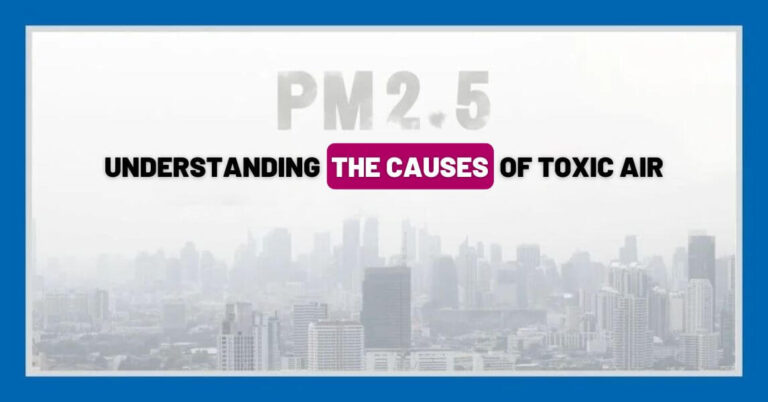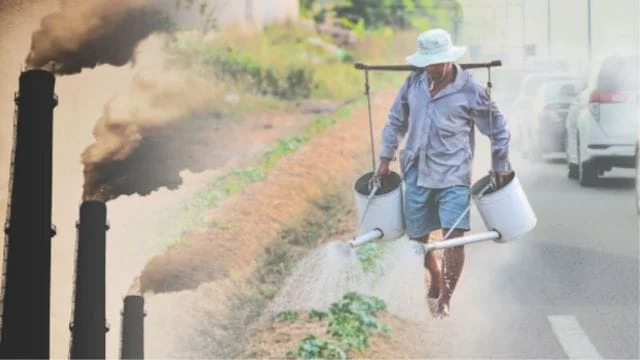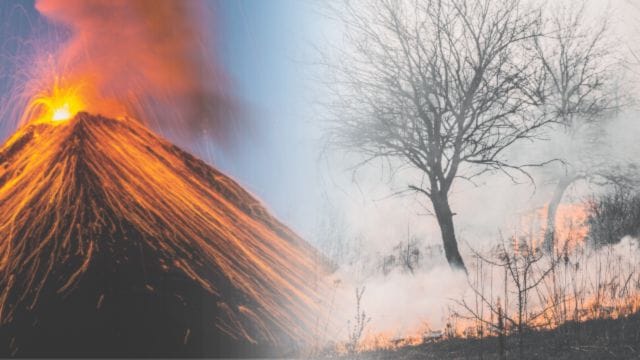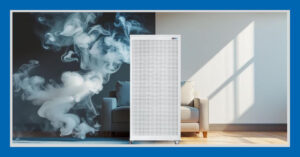Your cart is currently empty!

PM 2.5 Dust: Causes, Origins & Health Impacts Explained
by Peemanus Tongpiem / July 9, 2025
The issue of PM 2.5 dust is a major concern for many, especially during the cold season and periods of open burning. This leads to a significant decrease in air quality, severely impacting health. If you’re wondering, “What causes PM 2.5 dust?” this article will guide you through the origins and main causes of this toxic dust in detail, along with its health impacts and prevention methods for everyone’s well-being. The pervasive problem of PM 2.5 dust is a key component of air pollution. (For an in-depth look at the causes, effects, and solutions to overall air pollution in Thailand, you can read more here.)
What is PM 2.5? Getting to Know the Invisible “Tiny Dust”
First, let’s understand what PM 2.5 is. PM stands for Particulate Matter, referring to tiny solid or liquid particles suspended in the air. The number 2.5 indicates the diameter of these particles in micrometers (microns), meaning they are 2.5 microns or smaller.
The danger of PM 2.5 dust lies precisely in its minuscule size. This allows it to easily penetrate our respiratory system, pass through the lungs into the bloodstream, and affect various organs in the body more extensively than larger dust particles. (Read more about the impacts of PM 2.5 on health and various organs in the body.)
What Causes PM 2.5 Dust? Origins and Main Causes
The sources of PM 2.5 dust can be broadly categorized into two main types: natural sources and human-caused (anthropogenic) activities.
1. Human-Caused Activities (Anthropogenic Sources)

These are the primary reasons for the current PM 2.5 dust problem, especially in urban areas and densely populated regions:
- Transportation and Commuting:
- Vehicle Exhaust Fumes: Especially from diesel vehicles, trucks, public transport, and older cars with incomplete fuel combustion, which release dust particles, sulfur dioxide (SO2), and nitrogen oxides (NOx) – precursors to PM 2.5.
- Wear and Tear of Tires and Brake Pads: Generates small dust particles that become airborne.
- Open Burning:
- Agricultural Burning: A significant cause in many areas, particularly in the North and Northeast, where crop residues (rice stubble, sugarcane, corn, etc.) are burned after harvest to prepare land for new planting, creating immense amounts of smoke and dust.
- Forest Fires: Both naturally occurring fires (e.g., from lightning) and those intentionally set by humans for hunting or expanding agricultural land.
- Waste Burning: The open burning of municipal waste in various communities.
- Industry and Power Generation:
- Industrial Factories: Emissions from production processes involving the combustion of fuels (coal, oil, natural gas) and the use of various chemicals.
- Power Plants: Especially those using fossil fuels for electricity generation, which release dust particles and toxic gases into the atmosphere.
- Construction:
- Dust from Construction: Activities like building construction, road work, and infrastructure development involving the movement of soil, sand, cement, and construction materials lead to widespread dust.
- Household Cooking:
- Biomass Fuel Use: Cooking with firewood, charcoal, or using charcoal stoves in households, particularly in rural or densely populated communities.
2. Natural Sources

Although less prevalent, these are contributing factors:
Health Impacts of PM 2.5 Dust
Inhaling and accumulating PM 2.5 dust over time can lead to both short-term and long-term health effects:
Guidelines for Preventing and Reducing PM 2.5 Impacts
While the PM 2.5 problem is complex, everyone can participate and protect themselves:
- Check Air Quality: Monitor PM 2.5 levels using reliable applications or websites (e.g., Air4Thai, IQAir) before leaving home. (Consider using air quality monitors for precise readings.)
- Wear Protective Masks: Wear an N95 mask or a certified hygienic mask correctly when outdoors, especially in areas with high dust levels.
- Reduce Outdoor Activities: Avoid exercising or engaging in outdoor activities when dust levels are high.
- Prevent Dust Entry Indoors: Keep doors and windows tightly closed. If you have an air purifier, use it consistently. (For recommendations, check our guide on the best air purifiers in Thailand or best large room air purifiers.)
- Maintain Health: Drink enough clean water and eat nutritious food, especially fruits and vegetables rich in antioxidants.
- Reduce Dust Generation:
- Reduce private car use; switch to public transportation.
- Maintain vehicles in good condition to prevent black smoke.
- Refrain from burning waste and activities that produce smoke.
- Support burning-free agriculture.
Bottom Line
PM 2.5 dust is an environmental problem arising from various causes, both natural and, more significantly, human activities. Understanding the root causes of this issue is the first step in addressing and jointly reducing its impacts, ensuring that the air we breathe is clean and safe for everyone in the long run.

Peemanus Tongpiem
เราให้ความสำคัญกับอาหารที่เรารับประทาน 3 มื้อต่อวัน แต่เรากลับละเลยอากาศที่เราใช้หายใจมากกว่า 10 ครั้งต่อนาที เป็นเหตุให้ผมเริ่มค้นคว้าและเผยแพร่ความรู้เรื่องมลพิษทางอากาศ เพื่อให้ผู้คนตระถึงความสำคัญของการใช้เครื่องฟอกอากาศเพื่อสุขภาพที่ดีขึ้น







